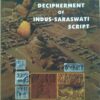In 1875 a steatite seal was found in the ruins of Harappa. Alexander Cunningham, the famous archeologist, suggested that Brahmi letters were derived from that unknown script.Nothing happened for the next 45 years. R.D. Banerjee excavated Mahenjodaro in 1921 and by the next 10 years the whole world came to know of the existence of one of the oldest civilizations in the world. People came to know about this civilization through the books and essays of John Marshall, M.S. Vats,Mackey and Sahani and many others.But the mystery which is still unsolved till date is the undeciphered scripts of Indus people. During the last 90 years we have got various suggestions but none has been
accepted unanimously. Here we have a quick look through the various attempts made by various researchers.1925- LA. Waddel claimed that Indus seals were written in Sumerian way.1931- C.J.Gadd in Marshal’s book made some suggestions having in mind the Vedic
literature.European scholars re-discovered the golden literary texts (Vedas, Puranas etc.) of ancient India from the Indian pundits. As those texts had mainly religious and ritualistic use which was the domain of a particular class,common and ordinary people had but little or no idea about them.Various languages and scripts through the ages had developed in India which had only phonetic similarities with the so-called Sanskrit / Vedic texts.Since no uniform script could be found for Sanskrit, Devnagari was accepted as a standard.
It is presumed that scripts like Devnagari, Bengali, Marathi eto. were shaped from Brahmi, the origin of which is unknown. But we know that, Vedic texts were composed long before Brahmi era. Therefore, two different styles
developed in Indian epigraphy (one for religious and literary purposes and
the other, for the need of the common). The 1st system was lost with time,
but the 2nd method survived through evolution.Harappan people inscribed their texts for their daily needs. On the other
hand, Vedic pundits used to write on meterials like ‘Bhurjapatra’ and / or
clothes which have already perished. This book is to read Indus scripts and
to establish the journey of Indian epigraphy from the Harappan age down
to the present Indian scripts through Brahmi.
Decipherment Of Indus-Saraswati Script -Rajot N. Pal
Click on the button below to contact us on WhatsApp, and buy.
HOW TO PAY
You can pay send your payment at any of the following UPI IDs, or scan the QR code, or send the payment directly to our bank:
INDIA POST PAYMENTS BANK

(IPPB) UPI ID= 9563646472@postbank
Malay De Sarkar
A/C No: 100005759940
IFSC: IPOS0000001
Mobile: 9563646472
STATE BANK OF INDIA

(SBI) UPI ID= 9563646472@sbi
Malay De Sarkar
A/C No: 32004843406
IFSC: SBIN0000162
Mobile: 9563646472


